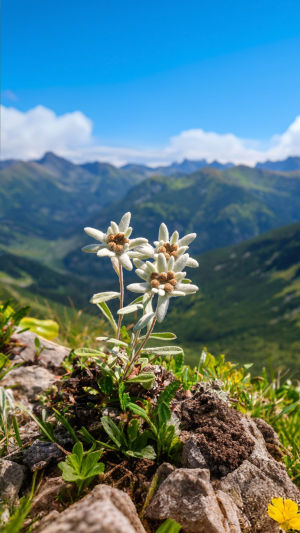High in the world's mountains, where oxygen is scarce, temperatures drop drastically, and winds rage across the landscape, some of the planet's most resilient plants thrive.
Alpine plants grow in environments that seem inhospitable to life. Yet these species have developed incredible adaptations that allow them to survive — and even flourish — in the most extreme altitudes on Earth.
<h3>What Are Alpine Plants?</h3>
Alpine plants are species that live above the tree line in mountainous regions, where conditions are too harsh for trees to grow. These environments can be found in ranges such as the Himalayas, Alps, Andes, and Rockies. Alpine plants must endure strong UV radiation, dramatic temperature swings, limited nutrients, and short growing seasons. Most grow low to the ground and display compact shapes — all clues to their survival strategy.
<h3>Staying Close to the Ground</h3>
One of the most noticeable features of alpine plants is their compact, low-growing form. This isn't just a quirk of appearance — it's a critical survival mechanism. By growing low, these plants avoid strong alpine winds that would dry out or damage taller species. The compact form also helps them trap heat from the sun and conserve moisture close to the soil surface. Some even grow in tight cushion shapes, forming dense mats that resist cold and collect warmth.
<h3>Beating the Cold</h3>
Surviving freezing temperatures is no small feat. Alpine plants often contain natural antifreeze compounds in their cells, such as sugars and proteins that prevent ice crystals from forming and damaging tissues. Others are capable of tolerating frozen water within their cells by carefully controlling how and where it forms. Many alpine plants also use a strategy called "supercooling," allowing their tissues to cool below freezing without forming damaging ice.
<h3>Using Sunlight Wisely</h3>
High altitudes receive stronger ultraviolet (UV) radiation due to the thinner atmosphere. While this can be harmful, alpine plants have adapted by producing protective pigments, such as anthocyanins, which act like natural sunscreens. These pigments often give plants a reddish or purplish hue. Some leaves also have thick cuticles or fine hairs that reflect excessive sunlight while still allowing for photosynthesis.
<h3>Short and Speedy Growth</h3>
Alpine summers are short — sometimes just a few weeks long. To take advantage of this tiny window of opportunity, alpine plants grow quickly and flower early. Many species begin blooming as soon as the snow melts, while others have buds that overwinter under the snow and burst open within days of spring's arrival. Their fast-paced life cycles ensure reproduction before conditions turn harsh again.
<h3>Rooted in Harsh Soil</h3>
Alpine soils are often rocky, shallow, and low in nutrients. To cope, alpine plants have extensive root systems that spread wide or deep to search for moisture and nutrients. Some also form symbiotic relationships with soil fungi (mycorrhizae), which help them absorb phosphorus and other hard-to-get nutrients. These partnerships are vital in nutrient-poor environments.
<h3>Reproduction in the Cold</h3>
Pollination can be tricky at high altitudes where few insects venture. Some alpine flowers have evolved to self-pollinate, ensuring seed production even if pollinators are scarce. Others use bright colors and strong scents to attract the few alpine insects available. Their flowers are often shaped to retain warmth, making them inviting microclimates for pollinators like bees and flies.
<h3>Famous Examples of Alpine Plants</h3>
• Edelweiss (Leontopodium alpinum): A symbol of mountain strength, this woolly plant is found in the Alps and resists cold with hairy leaves.
• Moss Campion (Silene acaulis): Forms cushion-shaped mats that grow extremely slowly but can live for centuries.
• Alpine Forget-me-not (Myosotis alpestris): Blooms with bright blue flowers in the Himalayas and Arctic regions alike.
• Gentians (Gentiana spp.): Known for their deep blue flowers, these grow across alpine zones worldwide and attract pollinators with vivid color.
<h3>Climate Change Threats</h3>
Sadly, alpine plants face growing threats from climate change. As global temperatures rise, tree lines shift upward, pushing alpine species into ever-smaller areas. Some species may run out of habitat entirely. Researchers from the University of Gothenburg found that many European alpine plants are already retreating to higher elevations. Protecting mountain environments and monitoring these plants is key to conserving biodiversity at high altitudes.
<h3>What Can We Learn from Alpine Plants?</h3>
Alpine plants are more than just survivors — they're teachers of resilience. Their adaptations offer insights into climate response, biological engineering, and even agriculture. Some researchers are studying their genetic traits to understand cold resistance in crops, which may prove valuable for future farming in a changing climate.
<h3>Conclusion: Small Plants, Big Lessons</h3>
Though small and often overlooked, alpine plants are champions of endurance and innovation. They survive where few others can, teaching us how life adapts and thrives in even the harshest corners of the planet.
Have you ever encountered these hardy plants during a mountain hike? Next time you're up high, take a closer look at the wildflowers and mosses underfoot — they just might be nature's toughest heroes in disguise.





